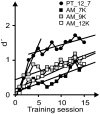Auditory discrimination learning and knowledge transfer in mice depends on task difficulty
- PMID: 20404159
- PMCID: PMC2889563
- DOI: 10.1073/pnas.0912357107
Auditory discrimination learning and knowledge transfer in mice depends on task difficulty
Abstract
Mice reproduce interesting effects in auditory discrimination learning and knowledge transfer discussed in human studies: (i) the advantage in the transfer from a hard to an easy task by benefits from transfer of procedural knowledge and information-integration learning, and (ii) the disadvantage in the transfer from easy to hard tasks by inability to generalize across perceptually different classes of stimuli together with initially unsuccessful attempts to transfer cognitive skills from one task to the other. House mice (NMRI strain) were trained in a shuttle-box stimulus discrimination task. They had to discriminate either between two pure tones of different frequencies (PT) or between two different modulation frequencies of an amplitude-modulated tone (AM). Then transfer of knowledge between these two tasks was tested. Mice rapidly learned PT discrimination within two to three training sessions (easy task). AM discrimination learning took longer and did not reach the high performance level of PT discrimination (hard task). No knowledge transfer was detected in animals first trained with the easy (PT) followed by the hard (AM) discrimination task. Mice benefited, however, from knowledge transfer when the AM discrimination was followed by the PT discrimination. When the task changed, confusion of conditioned stimuli occurred if the carrier frequency of the AM was the same as one of the frequencies in the PT task. These results show a hard-to-easy effect when possible knowledge transfer is tested between qualitatively different stimulus classes. The data establish mice as promising animal model for research on genetics of auditory perception and learning.
Conflict of interest statement
The authors declare no conflict of interest.
Figures




Similar articles
-
Easy-to-hard effects in perceptual learning depend upon the degree to which initial trials are "easy".Psychon Bull Rev. 2019 Dec;26(6):1889-1895. doi: 10.3758/s13423-019-01627-4. Psychon Bull Rev. 2019. PMID: 31243721 Free PMC article.
-
Temporal specificity of perceptual learning in an auditory discrimination task.Learn Mem. 2003 Mar-Apr;10(2):141-7. doi: 10.1101/lm.55503. Learn Mem. 2003. PMID: 12663752 Free PMC article.
-
Auditory Discrimination Learning: Role of Working Memory.PLoS One. 2016 Jan 22;11(1):e0147320. doi: 10.1371/journal.pone.0147320. eCollection 2016. PLoS One. 2016. PMID: 26799068 Free PMC article.
-
Auditory perceptual learning and changes in the conceptualization of auditory cortex.Hear Res. 2018 Sep;366:3-16. doi: 10.1016/j.heares.2018.03.011. Epub 2018 Mar 12. Hear Res. 2018. PMID: 29551308 Review.
-
Active listening: task-dependent plasticity of spectrotemporal receptive fields in primary auditory cortex.Hear Res. 2005 Aug;206(1-2):159-76. doi: 10.1016/j.heares.2005.01.015. Hear Res. 2005. PMID: 16081006 Review.
Cited by
-
Critical role for cochlear hair cell BK channels for coding the temporal structure and dynamic range of auditory information for central auditory processing.FASEB J. 2012 Sep;26(9):3834-43. doi: 10.1096/fj.11-200535. Epub 2012 Jun 12. FASEB J. 2012. PMID: 22691916 Free PMC article.
-
Population coding of time-varying sounds in the non-lemniscal Inferior Colliculus.bioRxiv [Preprint]. 2023 Aug 16:2023.08.14.553263. doi: 10.1101/2023.08.14.553263. bioRxiv. 2023. Update in: J Neurophysiol. 2024 May 1;131(5):842-864. doi: 10.1152/jn.00013.2024. PMID: 37645904 Free PMC article. Updated. Preprint.
-
Prior experience modifies acquisition trajectories via response-strategy sampling.Anim Cogn. 2023 Jul;26(4):1217-1239. doi: 10.1007/s10071-023-01769-y. Epub 2023 Apr 10. Anim Cogn. 2023. PMID: 37036556 Free PMC article.
-
Automated Behavioral Experiments in Mice Reveal Periodic Cycles of Task Engagement within Circadian Rhythms.eNeuro. 2019 Oct 2;6(5):ENEURO.0121-19.2019. doi: 10.1523/ENEURO.0121-19.2019. Print 2019 Sep/Oct. eNeuro. 2019. PMID: 31488550 Free PMC article.
-
Sensory cortex lesion triggers compensatory neuronal plasticity.BMC Neurosci. 2014 May 1;15:57. doi: 10.1186/1471-2202-15-57. BMC Neurosci. 2014. PMID: 24886276 Free PMC article.
References
-
- Delhommeau K, Micheyl C, Jouvet R, Collet L. Transfer of learning across durations and ears in auditory frequency discrimination. Percept Psychophys. 2002;64:426–436. - PubMed
-
- Demany L, Semal C. Learning to perceive pitch differences. J Acoust Soc Am. 2002;111:1377–1388. - PubMed
-
- Grimault N, Micheyl C, Carlyon RP, Bacon SP, Collet L. Learning in discrimination of frequency or modulation rate: Generalization to fundamental frequency discrimination. Hear Res. 2003;184:41–50. - PubMed
MeSH terms
LinkOut - more resources
Full Text Sources

